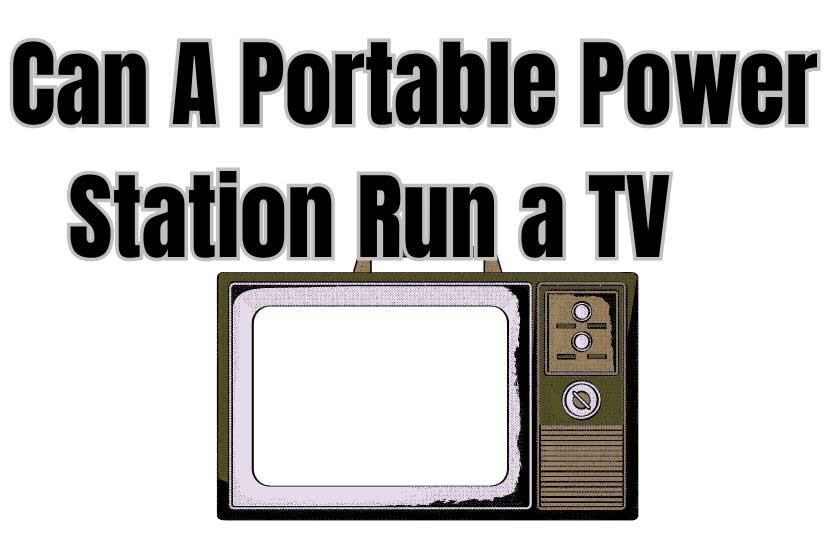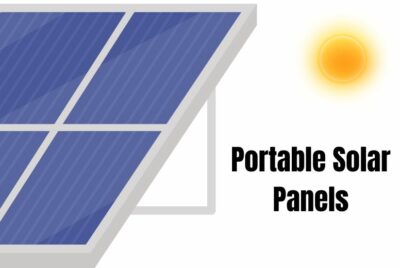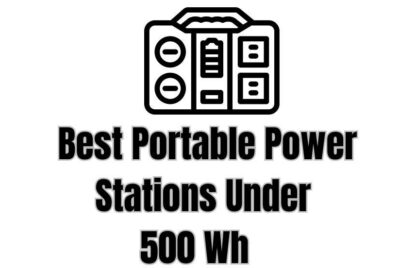Can A Portable Power Station Run A TV?
I may earn a commission for purchases made through my links. It helps me run this site. Check out my disclosure for more details.
Question – Are portable power stations powerful enough to run a TV? And for how long? What about those new fancy 75″ OLED TVs – Can I run one of those in my off-road rig and maybe get an outdoor air cinema going? In a moment, you’ll find the answer to the question, which we think you really know. So as well as that, we’ll also delve into the process of connecting a TV to a portable power station and powering it safely. By the end of this guide, you’ll have a clear understanding of how portable power stations work and how they can be used to run a TV, especially during off-grid or off-road leisure breaks or during grid failures.
Will a portable power station run a TV?
Yes, a portable power station can run a TV. Portable power stations are designed to provide a reliable power source for all types of electronic devices and any household product with a plug. In this article, we will explore the specifics of using one to power your TV and the considerations to keep in mind.
How Portable Power Stations Work
Now you know the answer to the question, let’s have a look at how solar powered portable power stations work.
Portable power stations have really hit the mainstream, and the buying trend is on an exponential rise.

North America is dominating the market, and it is set to reach $630 Billion by 2030. A threefold increase on 2022. These compact energy-storing boxes store electrical energy inside internal batteries and then convert it into usable power for devices. They have intelligent battery management systems (BMS) built in inverters that provide clean, regulated electrical current in the form of AC power to your devices, usually by way of a pure sine wave inverter, which is controlled power, which stops your plugged-in devices from receiving a power surge and short circuiting.
And what’s even better than that for energy-conscious people is that they work with solar panels, so you can get free, clean electricity after you have bought or paid off your system. So naturally, they are a favorite of campers, off-roaders, and those who like to venture off the beaten track. They are also an excellent mobile power source to take with you to power drills and tools when you are working on site without a power source, and they can be a brilliant means to power essential medical equipment that has to be used outdoors in emergency situations.
Naturally, they are an incredible home backup power source when the grid fails or after a severe weather front. You can even spec up a system to practically entirely replace your grid use, or to supplement it and feed power back into the grid.
Battery Capacity and Output
The battery capacity (measured in watt-hours Wh) and the power output (measured in watts W) of a portable power station are the two main specifications to pay attention to as these dictate its capabilities and performance. In this section, we will delve deeper into these two aspects and explore their significance in the functioning of a portable power station.
The battery capacity of a portable power station refers to the amount of energy it can store. This is important to pay attention to as you can work out how long it will power your appliances and devices. This is usually measured in watt-hours (Wh) or ampere-hours (Ah). The higher the battery capacity, the more energy the power station can store, and the longer it can power your devices. For example, a power station with a battery capacity of 500Wh can theoretically power a 50W device for 10 hours (500Wh/50W = 10 hours).
Naturally this also determines the price of a power station. You can purchase power stations for under $200 and these will usally be limited to under 250 Wh. You can purchase power stations that have 2000-6000 Wh of power. The Yeti 6000X has a 6071 watt-hours capacity and the extremely popular EcoFlow Delta Pro has 3600 Wh capacity but it can be upgraded to 25, 000 Wh by adding extra units, batterries and smart generators. Now that would be a complete home backup system and it would run more than your TV. It would power your entire home.
Now the Yeti 6000X and EcoFlow Delta systems are large units weighting up to 60 pounds, so they aren’t exactly mobile for overnight camping or RV trips hen you just want to go light and power a few lights, keep your radio and phones going and power your electric grill or coffee maker. There are many lighter units to choose from by the heavy hitters EcoFlow & Bluetti, and many from smaller, capable brands like TAKKI and FlashFish. The key is to consider your power needs and what devices and appliances you need to run and for how long.
This will determine the size of the power station you need and whether you need to invest in a complete solar generator kit, which will include the power station and one or more solar panels. If you plan on using power-hungry appliances like a coffee maker, electrical grill, or refrigerator, as well as your TV or mini-fridge, you will need a power station with a higher battery capacity. But if you only need to charge small devices like smartphones and tablets, a power station with a lower battery capacity will be all you need.
If your TV operates at 100 watts, you will be able to run it for 10 hours with a 1000 Wh power station like the Jackery Explorer 1000 (review). After that, you will have to charge it. But if you are running it in or close to your RV, you can charge it via the cigarette port as you travel between destinations, and you can also charge it when your RV or auto is stationary, as well as combining or using solar alone. Power stations can also be charged with AC power, which is useful to do before you leave home or at a camp site with electric sockets.
Here’s some other things the Jackery E1000 will run:
| Device/Appliance | Power Consumption (Watts) | Estimated Run Time (Hours) |
|---|---|---|
| Smartphone | 5 | 200+ |
| Tablet | 10 | 100+ |
| Laptop | 50 | 20+ |
| LED Light | 10 | 100+ |
| Mini Fridge | 45 | 22 |
It is worth noting that the actual runtime of a power station may vary depending on factors such as the age and condition of the battery, the temperature, and the power draw of the connected devices. Battery life is measured in cycles, and the 1002 Wh Jackery Explorer 1000, for instance, has a 500 battery life cycle to 80%+. That means after it has been charged 500 times, the battery will start to diminish and drop to just about 80% of it’s original capacity, which would be around 800 Wh.
Therefore, it is always a good idea to know the battery capacity so you can work out if you have enough power to last through your outdoor trip or power outages. if you are storing your system for emergency use.
Watts
The output capacity of a portable power station specifies how much power it can deliver to connected devices. This is usually measured in watts (W) and is an essential factor to consider when choosing a power station. The output capacity determines the types of devices you can power and the number of devices you can charge simultaneously.
Most portable power stations come with multiple output ports, including AC outlets, USB ports, and DC ports. The total output capacity of these ports determines the maximum power you can draw from the power station at any given time. For example, a power station with a total output capacity of 300W can power a 200W device and a 100W device simultaneously, but it cannot power two 200W devices at the same time.
It is crucial to check the output capacity of a power station and ensure it is compatible with the devices you plan on using. Some devices, such as laptops and TVs, may require a higher output capacity, while smaller devices like smartphones and tablets may only need a lower output capacity.
Several factors can affect the battery capacity and output of a portable power station. These include:
- The type and quality of the battery used in the power station
- The temperature, as extreme temperatures can affect the performance of the battery
- The age and condition of the battery, as older batteries may have reduced capacity and output
- The power draw of the connected devices, as higher power devices will drain the battery faster
- The efficiency of the power station, as some models may have a higher conversion rate from stored energy to usable power
Choosing the Right Portable Power Station To Run A TV
When it comes to selecting a portable power station for running a TV, one of the most important factors to consider is the wattage requirements. This refers to the amount of power needed to run the TV and is measured in watts. It is crucial to ensure that the power station’s output capacity meets or exceeds the power consumption of the TV to ensure smooth and uninterrupted operation.
Here are some key points to keep in mind when determining the wattage requirements for your TV:
- Check the TV’s power consumption: The first step is to check the TV’s user manual or the label on the back of the TV to determine its power consumption. This will typically be listed in watts (W) or amps (A).
- Consider the TV’s size and type: The size and type of TV can also impact its power consumption. For example, a larger TV or one with a higher resolution may require more power to run.
- Factor in additional devices: If you plan on using other devices, such as a streaming device or gaming console, with your TV, make sure to include their power consumption in your calculations.
Once you have determined the power consumption of your TV and any additional devices, you can use this information to find a suitable portable power station. Here are some tips to help you choose the right one:
- Look for a power station with a higher wattage output: To ensure that your TV can run smoothly and for longer, it’s best to choose a power station with a higher wattage output than the TV’s power consumption. This will also allow you to power other devices simultaneously. You don’t want your TV to die in the middle of a new Scorsese 4 hour epic.
- Consider the power station’s total capacity: In addition to the wattage output, it’s important to consider the total capacity of the power station. This refers to the amount of energy it can store and is typically measured in watt-hours (Wh). The higher the capacity, the longer the power station will be able to run your TV.
- Take into account the power station’s outlets: Make sure the power station has the appropriate outlets to power your TV. Some may have AC outlets, while others may only have USB ports.
It’s also worth noting that some power stations may have a surge capacity, which allows them to handle a temporary increase in power demand. This can be useful if your TV has a higher power consumption during start-up.
Overall, when it comes to wattage requirements for a portable power station, it’s important to consider the specific needs of your TV and any additional devices you plan on using. By doing so, you can ensure that you choose a power station that can provide enough power to keep your TV running smoothly and uninterrupted.
Portability and Weight
When choosing a portable power station, it is important to consider its portability and weight. This can greatly impact its convenience and usability, especially if you plan on using it in various locations. Some power stations may be too heavy and bulky to carry around, while others may be lightweight and compact enough to fit in a backpack.
Connecting the TV to the Station
Connecting a TV to a portable power station only requires connecting the plug into the AC socket in your power station, which has to naturally have a high enough wattage to cope with the wattage rating of your TV. You also have to allow for any other devices or appliances plugged into your power station that are eating into the available wattage your power station can output. You may also have to plug in any satellite receivers, set top boxes, hard disk recorders, or consoles, so allow for the wattage requirement of them and make sure the power station you are looking at has multiple AC sockets; some have up to 6.
PowerStation TV Connection Checklist
- Check the Input Power Requirements of Your TV: Before connecting your TV to a portable power station, it is important to know the input power requirements of your TV. This information can usually be found on the back of your TV or in the user manual. Make sure to take note of the voltage and amperage requirements.
- Choose the Right Cables and Adapters: Once you know the input power requirements of your TV, you can choose the appropriate cables and adapters to connect it to the power station. It is important to use compatible cables and adapters to ensure a secure and efficient connection.
- Understand the Output Options of the Power Station: Portable power stations come with different output options, such as AC outlets, USB ports, and DC ports. Make sure to check the output options of your power station and choose the one that is suitable for your TV.
- Use the Correct Cable for the Job: When connecting your TV to the power station, it is important to use the correct cable for the job. For example, if your TV has a DC input, make sure to use a DC cable to connect it to the power station. Using the wrong cable can result in damage to your TV or the power station.
- Consider Using a Surge Protector: To protect your TV from power surges, it is recommended to use a surge protector between the power station and your TV. This can help prevent any damage to your TV in case of a power surge. Check if your power station has any issues with extensive leads or reels.
- Make sure you have allowed for all the extra AC sockets you need for the full surround-sound cinema experience if you are plugging in speakers, amplifiers, satellite receivers, or gaming consoles, to name just a few accessories you may want to use.
By following these steps, you can safely and effectively connect your TV to a portable power station. This allows you to enjoy your favorite shows and movies even when you’re off the grid or experiencing a power outage.
Powering the TV Safely
When it comes to powering a TV with a portable power station, safety should always be a top priority. While these power stations are designed to provide reliable and convenient power, it’s important to follow the manufacturer’s guidelines and take the necessary precautions to avoid any potential electrical issues.
- Before connecting your TV to a portable power station, make sure to read the manufacturer’s instructions carefully.
- Check the power input requirements for your specific TV model and ensure that the power station can handle it.
- Using a power station with insufficient power output can lead to overloading and potential damage to both the TV and the power station.
It’s important to keep an eye on the power consumption of your TV when using a portable power station. This can help prevent overloading and ensure that the power station is functioning properly.
- Check the wattage of your TV and compare it to the power output of the power station.
- Consider using a power meter to monitor the power consumption in real-time.
- If you notice any fluctuations or spikes in power consumption, it’s best to turn off the TV and investigate the issue before continuing use.
Portable power stations can generate heat when in use, so it’s important to ensure proper ventilation to prevent overheating and potential fire hazards.
- Place the power station in a well-ventilated area, away from any flammable materials.
- Do not cover the power station or place it in an enclosed space.
- Consider using a fan to help with air circulation around the power station.
In addition to the above precautions, here are a few more tips to keep in mind when using a portable power station to power your TV:
- Always use the appropriate cables and connectors to connect your TV to the power station.
- Do not use damaged or frayed cables.
- Do not attempt to modify or repair the power station yourself.
- If you notice any unusual smells, sounds, or behavior from the power station, stop using it immediately and contact the manufacturer for assistance.
By following these guidelines and taking necessary precautions, you can safely and reliably power your TV with a portable power station. Remember to always prioritize safety and refer to the manufacturer’s instructions for any specific questions or concerns.
Conclusion
In conclusion, portable power stations are fantastic alternative energy solutions that can effectively power a TV, whether you’re on the move, live off-grid or use it as a backup power supply. Understanding the power and battery stats of portable power stations work will help you choose the right model based on your specific power requirements. By following these guidelines for using a portable power station to run a TV, you can enjoy seamless entertainment and stay connected even in remote or emergency scenarios.




